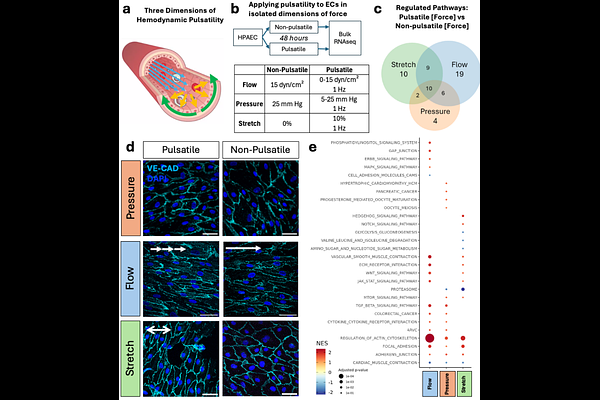Pulsatile flow dynamics determine pulmonary arterial architecture

Pulsatile flow dynamics determine pulmonary arterial architecture
Spurgin, S. B.; Thai, L.; Wan, T.; Chaney, C.; Cowdin, M. A.; VERRAM REDDY, S. R.; Hussain, T.; Fares, M.; Spearman, A. D.; Cleaver, O.
AbstractBACKGROUND Single ventricle congenital heart disease (SV-CHD) is a uniformly lethal condition. Survival depends upon the Glenn surgery, which shunts venous blood directly to the pulmonary arteries without the support of a pumping ventricle. In the context of this altered circulation (loss of cardiac-driven pulsatility), diverse pulmonary vascular complications develop, severely limiting survival. To date, the relationship between loss of arterial pulsatility and pulmonary vascular changes has not yet been investigated at the cellular level. METHODS: Using combined cardiac catheterization and cardiac MRI, we defined pulsatility loss in three dimensions (flow, pressure, and stretch) in the pulmonary arteries of SV-CHD patients in the Glenn stage. To assess the impact of pulsatility loss on endothelial cells (ECs), we exposed cultured human pulmonary artery endothelial cells to individual dimensions of force. We used bulk RNA sequencing, GSEA, ELISA, and immunofluorescent staining to investigate cellular changes. A rat model of the Glenn circulation was used to further assess the cellular adaptation of pulmonary arteries to non-pulsatile hemodynamic forces. RESULTS: We identify and quantify pulsatility loss in Glenn patients, occurring in all three dimensions of hemodynamic force. We show unique transcriptional signatures of pulsatility within each dimension of force, affecting key structural and signaling pathways in ECs. We identify pulsatile stretch as a critical stimulus for endothelial secretion of PDGFB-a known driver of vascular smooth muscle cell (vSMC) proliferation and vascular wall recruitment. Moreover, we show that loss of arterial pulsatility in vivo leads to thinning of the vascular wall and reduction of VSMCs. CONCLUSIONS: This work identifies a novel and critical role for blood flow pulsatility in maintenance of the pulmonary vascular architecture. Our study provides a mechanistic understanding of the role of pulsatile, arterial forces in maintaining normal pulmonary vascular architecture through EC-SMC crosstalk. Arterial pulsatility is sensed by stretch of endothelial cells and relayed via PDGFB to the vascular smooth muscle, thus maintaining a vascular structure that can support arterial hemodynamic force.